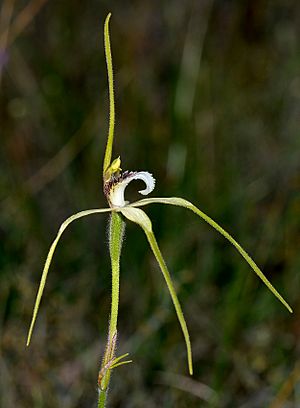Northern darting spider orchid facts for kids
Quick facts for kids Northern darting spider orchid |
|
|---|---|
 |
|
| Caladenia uliginosa subsp. candicans | |
| Scientific classification |
|
| Kingdom: | Plantae |
| Clade: | Tracheophytes |
| Clade: | Angiosperms |
| Clade: | Monocots |
| Order: | Asparagales |
| Family: | Orchidaceae |
| Subfamily: | Orchidoideae |
| Tribe: | Diurideae |
| Genus: | Caladenia |
| Species: |
C. uliginosa
|
| Subspecies: |
C. u. subsp. candicans
|
| Trinomial name | |
| Caladenia uliginosa subsp. candicans Hopper & A.P.Br.
|
|
| Synonyms | |
|
|
The northern darting spider orchid (Caladenia uliginosa subsp. candicans) is a special type of orchid. It belongs to the orchid family and grows only in the south-west part of Western Australia. This means it is endemic to that area.
This orchid has a single leaf that feels a bit hairy. It also grows up to three pretty yellowish-cream flowers. A key part of its flower is the labellum, which sticks out forward. Unlike some other similar orchids, this labellum does not have a red tip.
What Does It Look Like?
The northern darting spider orchid is a ground-dwelling plant. It is a perennial herb, meaning it lives for more than two years and has soft stems. It grows from an underground tuber (a bit like a potato).
Each plant has one upright, hairy leaf. This leaf can be between 7 and 15 cm long and 7 to 10 mm wide. The plant produces a tall stem, about 20 to 30 cm high. On top of this stem, you can find up to three yellowish-cream flowers. Each flower is quite large, about 7 to 10 cm long and 4 to 5 cm wide.
The flower's sepals and petals have thin, brownish tips that look like threads. The top sepal stands straight up. The side sepals and petals spread out horizontally near their base, then gently droop downwards.
The labellum is the most striking part. It is white and sticks out forward. It measures about 1.4 to 2.2 cm long and 7 to 10 mm wide. The sides of the labellum have short, upright teeth that can be red or white. Its tip curves downwards. In the middle of the labellum, there are four rows of small bumps called calli. These orchids usually bloom from late September to October.
How It Was Named
The main species, Caladenia uliginosa, was first described in 1984 by a scientist named Alex George. His description was published in a science journal called Nuytsia.
Later, in 2001, two other scientists, Stephen Hopper and Andrew Phillip Brown, looked closer at this orchid. They decided there were different types, or subspecies. They described three of these, including the subspecies candicans. This description was also published in Nuytsia. They found a sample of this particular orchid near a place called West Dale.
The name candicans comes from a Latin word. It means "shining white" or "bright." This name was chosen because of the bright white color of this orchid's labellum.
Where It Lives
You can find the northern darting spider orchid growing between the towns of York and Kojonup. These areas are part of the Avon Wheatbelt and Jarrah Forest biogeographic regions in Western Australia.
This orchid often grows in woodlands where wandoo trees are common. It can also be found in areas that get wet during certain seasons, or along small streams and drainage lines.
Conservation Status
The Western Australian Government's Department of Parks and Wildlife has looked at the northern darting spider orchid. They have classified it as "not threatened." This means it is not currently at risk of disappearing.

